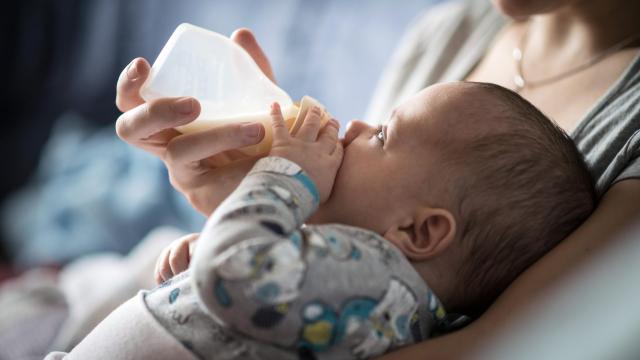If you feed — or plan to feed — your newborn formula, you might be wondering for how long you will need to do so. When is the right time to wean them? How will you know when they’re ready? While there’s no magic “formula,” here are a few basic guidelines.
When is the right time to wean?
According to the Mayo Clinic, “Infant formula is generally recommended until age 1, followed by whole milk until age 2 — but talk to your child’s doctor for specific guidance.”
The key factor is that your baby is healthy and getting enough nutrients from solid table food (that they previously relied on mineral and nutrient-fortified formula to provide). If their diet is nutritionally balanced and includes a mix of fruits, vegetables, protein, and grains, they may even be ready to wean off formula before they’re 1 year old. (But still don’t introduce cow’s milk until after their first birthday — there’s too much protein it it for a baby’s digestive system and kidneys to process, which can lead them to develop anemia and intestinal bleeding.)
Note, however, that some babies will need to continue longer with formula if they aren’t gaining enough weight, were born prematurely, have food allergies, or have not yet established a solid diet of table food. Consult with your doctor if you suspect any of these conditions may be a factor.
Why is it important to wean?
If a toddler knows a bottle is still available, they may fill up on formula rather than eating solids, and miss out on important nutrients in their diet. Drinking formula before nap-time and bedtime can also promote tooth decay. But, after a year of daily enjoyment, how do you get them to give up their beloved, oh-so-comforting bottles?
How to help your baby wean off formula
Quitting the bottle cold turkey is a tough proposition; most babies will fare better with a gradual transition. If your baby tolerates cow’s milk well, give them small servings of milk where they would normally receive formula (in two to four ounce portions). Over the next 7–10 days, increase milk while decreasing formula servings until the formula is phased out.
If they don’t take to cow’s milk right away, you’ll need to be a bit sneakier. Mix two ounces of prepared formula (not powder) with two ounces of cow’s milk in the same bottle. Over the next week, gradually increase the proportion of milk until there is no formula left.
Other tips to go bottle-free
Introducing a sippy cup at six months, before you actually expect your baby to use it full-time, is a low-pressure way to let them know other ways of imbibing exist. They won’t have the hand-eye coordination to use it properly (without spilling), but the exposure is nonetheless helpful.
Help your baby drop one bottle at a time by replacing it with a sippy cup of milk — or solid food. Morning or mid-day bottles will be easier to drop than the pre-bedtime bottle, so start there. Once your babe has gotten over the hump and eliminated daytime bottles, change up their bedtime routine to make giving up their nighttime snack a little easier.
Be patient with your little one
Be patient with your baby and yourself. Habits are not broken overnight, especially when you have the mental discipline of, well, a 1-year-old. Move slowly, don’t expect miracles, and trust that your baby will not be taking that bottle to college. With consistency on your part (which means not caving and soothing them with a bottle every time they cry) it will happen soon enough.

Leave a Reply
You must be logged in to post a comment.